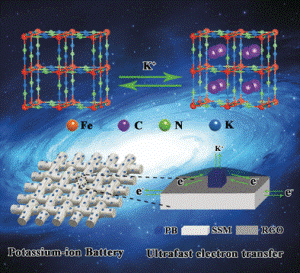Jun 12 2017
Chinese Scientists have used waste for a beneficial purpose while seeking for a unique solution to a technical problem by converting rusty stainless steel mesh into electrodes with exceptional electrochemical properties that enable them to be suitable for potassium-ion batteries.
Based on the report presented in the journal Angewandte Chemie, the rust is transformed directly into a compact layer with a grid structure capable of storing potassium ions. A coating of reduced graphite oxide results in an increase in the stability and conductivity during discharge/charge cycles.
 (C) Wiley-VCH
(C) Wiley-VCH
Effective energy storage within the grid is needed for increasing the use of renewable energy. Lithium ion batteries, extensively used in portable electronics are considered to be promising candidates. These batteries are based on the displacement of lithium ions. During the charging process, the ions travel toward the graphite electrode, where they are then stored between carbon layers. They are released when discharging. However, lithium is indeed expensive and reserves are limited. As an alternative, sodium ion batteries have been explored.
Potassium ions are just as inexpensive and readily available as sodium, and potassium ion batteries would be superior from the electric aspect. However, the significantly larger radius of the potassium ions has posed a problem. Repeated storage and release of these ions destabilizes the materials currently used in electrodes.
Xin-Bo Zhang
Zhang and a team from the Chinese Academy of Sciences and Jilin University (Changchun, China) recently discovered an elegant solution in their use of a waste material in order to produce unique electrodes: rejected stainless steel mesh from sieves and filters. Harsh conditions lead to some corrosion in spite of the exceptional durability of these grids. It is possible to reclaim the metal in a furnace, but this process needs a great deal of energy, time, and money, and also producing emissions.
Conversion into electrodes could develop into a more ecologically and economically sensible form of recycling.
Xin-Bo Zhang
The corroded mesh is dipped into a solution of potassium ferrocyanide, which refers to yellow prussiate of potash, called a fining agent for wine. This dissolves nickel ions, chromium and iron out of the rust layer. These blend with ferricyanide ions into the complex salt called Prussian blue, referring to a dark blue pigment deposited as scaffold-like nanocubes onto the surface of the mesh. Potassium ions can rapidly and effortlessly be stored in and released from these structures.
A dip-coating process is now used by the team to deposit a layer of graphene oxide (oxidized graphite layers). This layer nestles firmly onto the nanocubes. Subsequent reduction transforms the graphene oxide to reduced graphene oxide (RGO), which comprises of graphite with isolated oxygen atoms.
The RGO coating inhibits clumping and detachment of the active material. At the same time, it significantly increases the conductivity and opens ultrafast electron-transport pathways.
Xin-Bo Zhang
In tests, coin cells developed with these new electrodes demonstrate outstanding rate capability, discharge voltages, capacity and excellent cycle stability. Since the cost-effective, binder-free electrodes are extremely flexible, they are majorly ideal for use in flexible electronic devices.